Immigrant Nurses' Perceptions on Cultural Differences-Based Job Concerns
VerifiedAdded on 2023/01/23
|8
|2049
|26
AI Summary
This research paper explores the experiences of immigrant nurses working in Shanghai, China and their job concerns related to cultural differences. The study uses a qualitative methodology and Giorgi's phenomenological approach for data analysis. The recruitment strategy focuses on immigrant nurses, and the data collected addresses the research issue. However, ethical considerations and data analysis rigor could have been improved. The findings provide valuable insights into the perception of immigrant nurses in Shanghai.
Contribute Materials
Your contribution can guide someone’s learning journey. Share your
documents today.
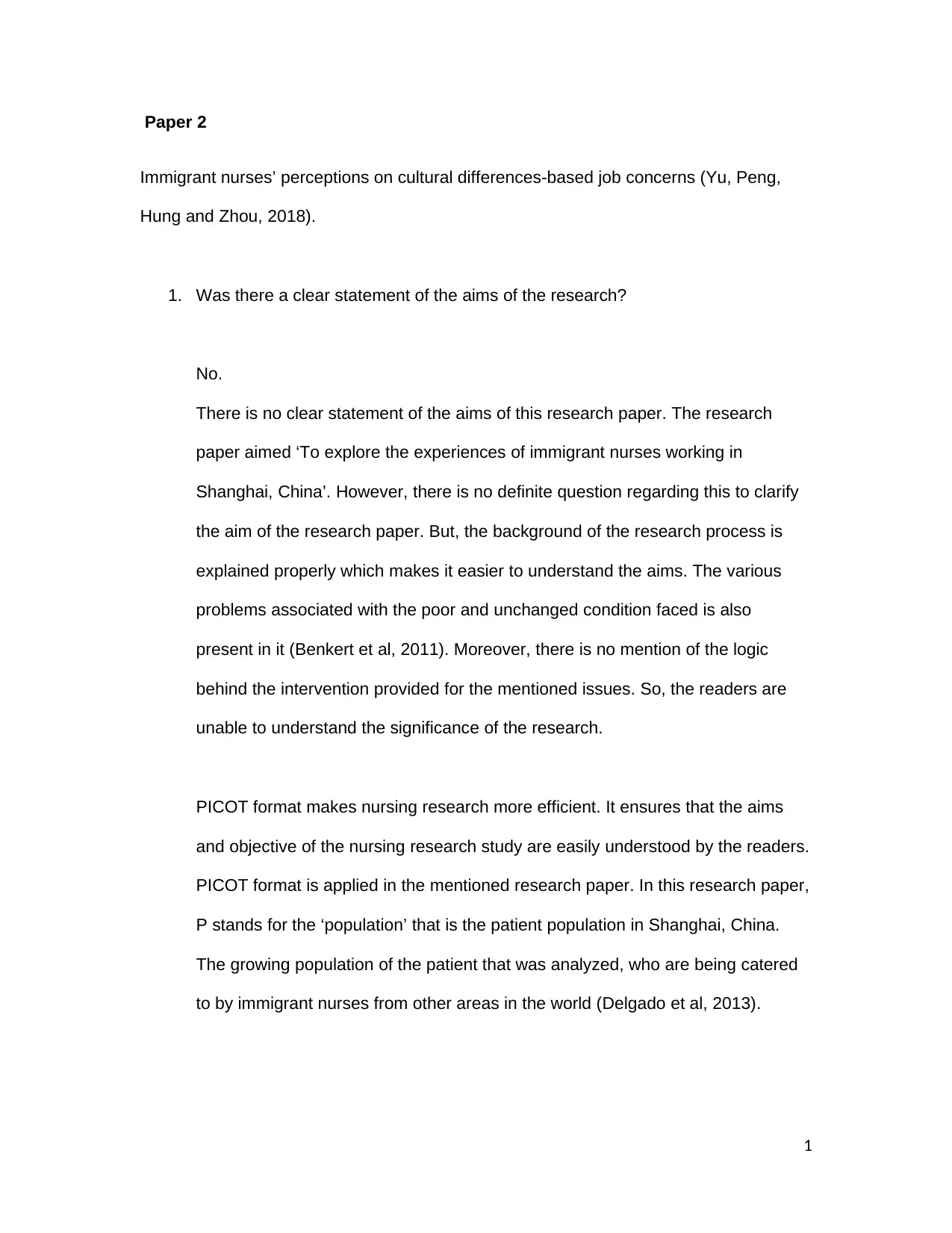
Paper 2
Immigrant nurses’ perceptions on cultural differences-based job concerns (Yu, Peng,
Hung and Zhou, 2018).
1. Was there a clear statement of the aims of the research?
No.
There is no clear statement of the aims of this research paper. The research
paper aimed ‘To explore the experiences of immigrant nurses working in
Shanghai, China’. However, there is no definite question regarding this to clarify
the aim of the research paper. But, the background of the research process is
explained properly which makes it easier to understand the aims. The various
problems associated with the poor and unchanged condition faced is also
present in it (Benkert et al, 2011). Moreover, there is no mention of the logic
behind the intervention provided for the mentioned issues. So, the readers are
unable to understand the significance of the research.
PICOT format makes nursing research more efficient. It ensures that the aims
and objective of the nursing research study are easily understood by the readers.
PICOT format is applied in the mentioned research paper. In this research paper,
P stands for the ‘population’ that is the patient population in Shanghai, China.
The growing population of the patient that was analyzed, who are being catered
to by immigrant nurses from other areas in the world (Delgado et al, 2013).
1
Immigrant nurses’ perceptions on cultural differences-based job concerns (Yu, Peng,
Hung and Zhou, 2018).
1. Was there a clear statement of the aims of the research?
No.
There is no clear statement of the aims of this research paper. The research
paper aimed ‘To explore the experiences of immigrant nurses working in
Shanghai, China’. However, there is no definite question regarding this to clarify
the aim of the research paper. But, the background of the research process is
explained properly which makes it easier to understand the aims. The various
problems associated with the poor and unchanged condition faced is also
present in it (Benkert et al, 2011). Moreover, there is no mention of the logic
behind the intervention provided for the mentioned issues. So, the readers are
unable to understand the significance of the research.
PICOT format makes nursing research more efficient. It ensures that the aims
and objective of the nursing research study are easily understood by the readers.
PICOT format is applied in the mentioned research paper. In this research paper,
P stands for the ‘population’ that is the patient population in Shanghai, China.
The growing population of the patient that was analyzed, who are being catered
to by immigrant nurses from other areas in the world (Delgado et al, 2013).
1
Secure Best Marks with AI Grader
Need help grading? Try our AI Grader for instant feedback on your assignments.
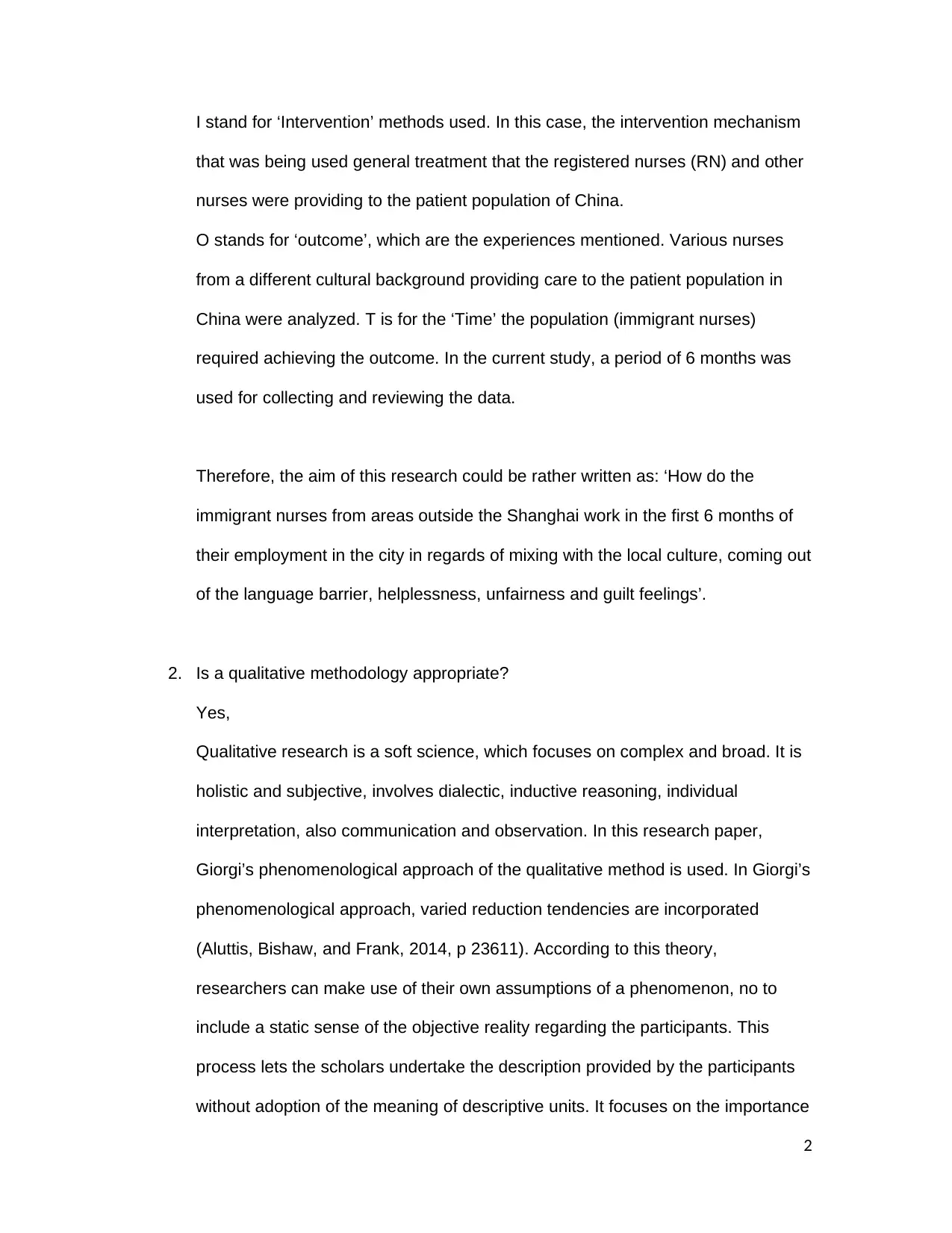
I stand for ‘Intervention’ methods used. In this case, the intervention mechanism
that was being used general treatment that the registered nurses (RN) and other
nurses were providing to the patient population of China.
O stands for ‘outcome’, which are the experiences mentioned. Various nurses
from a different cultural background providing care to the patient population in
China were analyzed. T is for the ‘Time’ the population (immigrant nurses)
required achieving the outcome. In the current study, a period of 6 months was
used for collecting and reviewing the data.
Therefore, the aim of this research could be rather written as: ‘How do the
immigrant nurses from areas outside the Shanghai work in the first 6 months of
their employment in the city in regards of mixing with the local culture, coming out
of the language barrier, helplessness, unfairness and guilt feelings’.
2. Is a qualitative methodology appropriate?
Yes,
Qualitative research is a soft science, which focuses on complex and broad. It is
holistic and subjective, involves dialectic, inductive reasoning, individual
interpretation, also communication and observation. In this research paper,
Giorgi’s phenomenological approach of the qualitative method is used. In Giorgi’s
phenomenological approach, varied reduction tendencies are incorporated
(Aluttis, Bishaw, and Frank, 2014, p 23611). According to this theory,
researchers can make use of their own assumptions of a phenomenon, no to
include a static sense of the objective reality regarding the participants. This
process lets the scholars undertake the description provided by the participants
without adoption of the meaning of descriptive units. It focuses on the importance
2
that was being used general treatment that the registered nurses (RN) and other
nurses were providing to the patient population of China.
O stands for ‘outcome’, which are the experiences mentioned. Various nurses
from a different cultural background providing care to the patient population in
China were analyzed. T is for the ‘Time’ the population (immigrant nurses)
required achieving the outcome. In the current study, a period of 6 months was
used for collecting and reviewing the data.
Therefore, the aim of this research could be rather written as: ‘How do the
immigrant nurses from areas outside the Shanghai work in the first 6 months of
their employment in the city in regards of mixing with the local culture, coming out
of the language barrier, helplessness, unfairness and guilt feelings’.
2. Is a qualitative methodology appropriate?
Yes,
Qualitative research is a soft science, which focuses on complex and broad. It is
holistic and subjective, involves dialectic, inductive reasoning, individual
interpretation, also communication and observation. In this research paper,
Giorgi’s phenomenological approach of the qualitative method is used. In Giorgi’s
phenomenological approach, varied reduction tendencies are incorporated
(Aluttis, Bishaw, and Frank, 2014, p 23611). According to this theory,
researchers can make use of their own assumptions of a phenomenon, no to
include a static sense of the objective reality regarding the participants. This
process lets the scholars undertake the description provided by the participants
without adoption of the meaning of descriptive units. It focuses on the importance
2
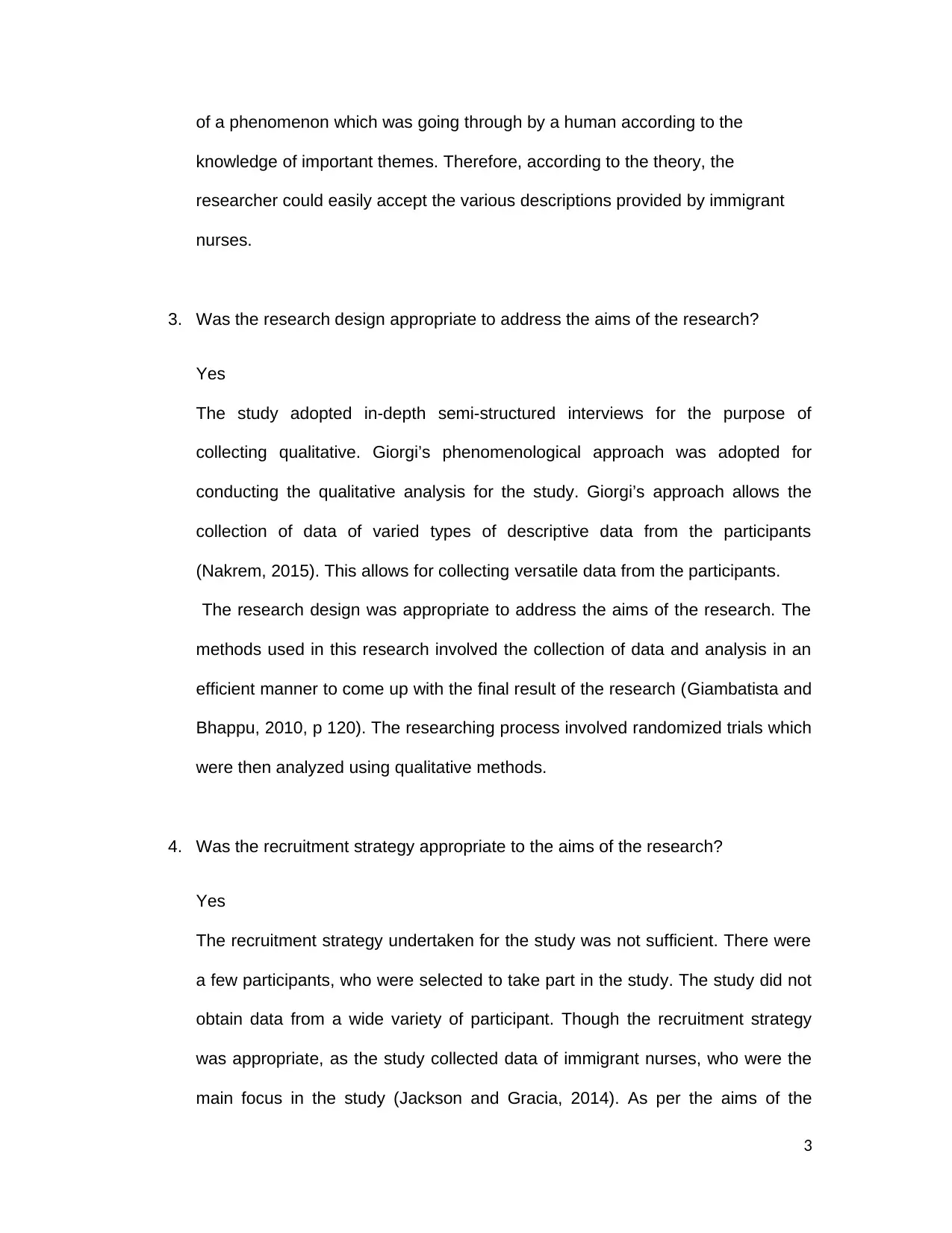
of a phenomenon which was going through by a human according to the
knowledge of important themes. Therefore, according to the theory, the
researcher could easily accept the various descriptions provided by immigrant
nurses.
3. Was the research design appropriate to address the aims of the research?
Yes
The study adopted in-depth semi-structured interviews for the purpose of
collecting qualitative. Giorgi’s phenomenological approach was adopted for
conducting the qualitative analysis for the study. Giorgi’s approach allows the
collection of data of varied types of descriptive data from the participants
(Nakrem, 2015). This allows for collecting versatile data from the participants.
The research design was appropriate to address the aims of the research. The
methods used in this research involved the collection of data and analysis in an
efficient manner to come up with the final result of the research (Giambatista and
Bhappu, 2010, p 120). The researching process involved randomized trials which
were then analyzed using qualitative methods.
4. Was the recruitment strategy appropriate to the aims of the research?
Yes
The recruitment strategy undertaken for the study was not sufficient. There were
a few participants, who were selected to take part in the study. The study did not
obtain data from a wide variety of participant. Though the recruitment strategy
was appropriate, as the study collected data of immigrant nurses, who were the
main focus in the study (Jackson and Gracia, 2014). As per the aims of the
3
knowledge of important themes. Therefore, according to the theory, the
researcher could easily accept the various descriptions provided by immigrant
nurses.
3. Was the research design appropriate to address the aims of the research?
Yes
The study adopted in-depth semi-structured interviews for the purpose of
collecting qualitative. Giorgi’s phenomenological approach was adopted for
conducting the qualitative analysis for the study. Giorgi’s approach allows the
collection of data of varied types of descriptive data from the participants
(Nakrem, 2015). This allows for collecting versatile data from the participants.
The research design was appropriate to address the aims of the research. The
methods used in this research involved the collection of data and analysis in an
efficient manner to come up with the final result of the research (Giambatista and
Bhappu, 2010, p 120). The researching process involved randomized trials which
were then analyzed using qualitative methods.
4. Was the recruitment strategy appropriate to the aims of the research?
Yes
The recruitment strategy undertaken for the study was not sufficient. There were
a few participants, who were selected to take part in the study. The study did not
obtain data from a wide variety of participant. Though the recruitment strategy
was appropriate, as the study collected data of immigrant nurses, who were the
main focus in the study (Jackson and Gracia, 2014). As per the aims of the
3
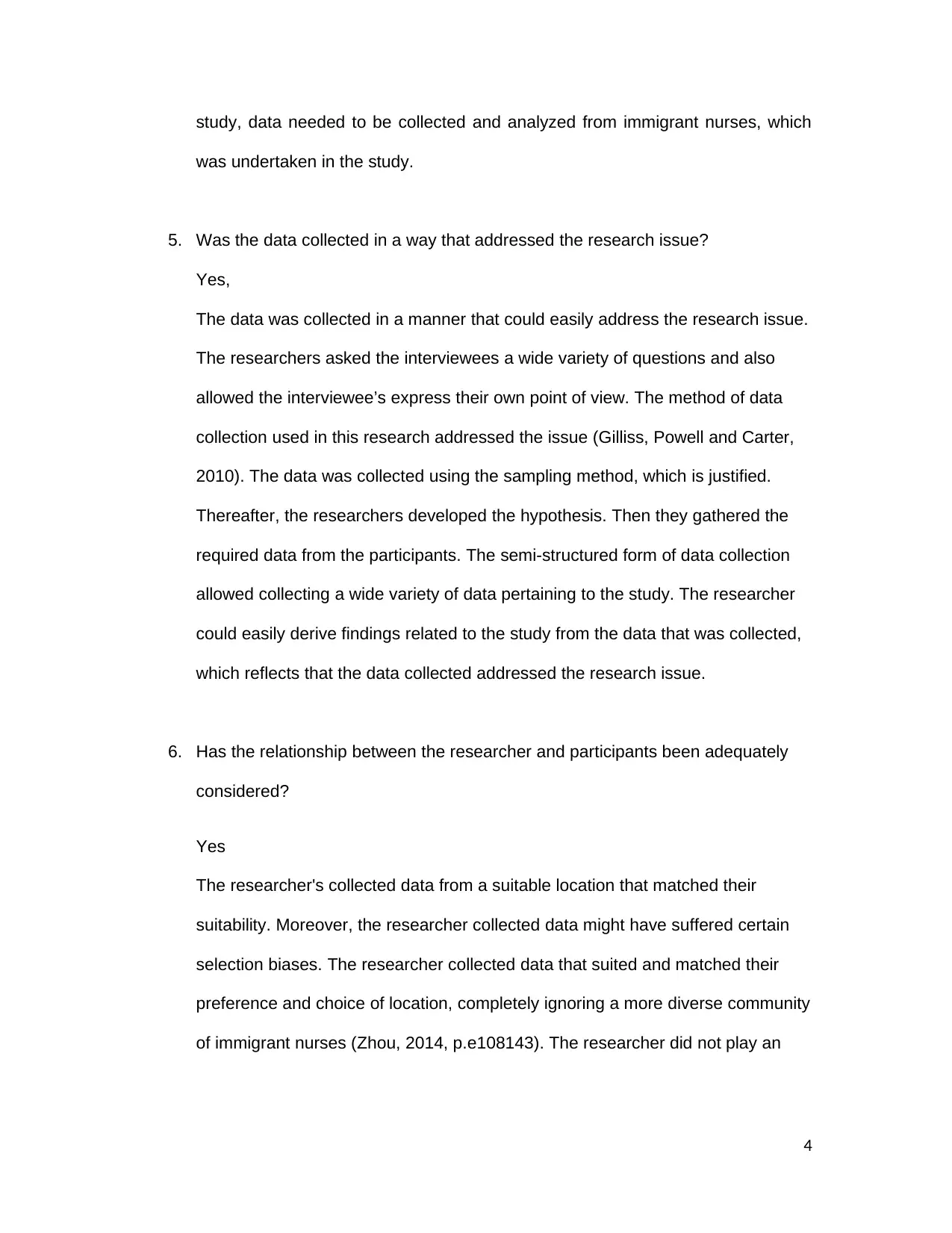
study, data needed to be collected and analyzed from immigrant nurses, which
was undertaken in the study.
5. Was the data collected in a way that addressed the research issue?
Yes,
The data was collected in a manner that could easily address the research issue.
The researchers asked the interviewees a wide variety of questions and also
allowed the interviewee’s express their own point of view. The method of data
collection used in this research addressed the issue (Gilliss, Powell and Carter,
2010). The data was collected using the sampling method, which is justified.
Thereafter, the researchers developed the hypothesis. Then they gathered the
required data from the participants. The semi-structured form of data collection
allowed collecting a wide variety of data pertaining to the study. The researcher
could easily derive findings related to the study from the data that was collected,
which reflects that the data collected addressed the research issue.
6. Has the relationship between the researcher and participants been adequately
considered?
Yes
The researcher's collected data from a suitable location that matched their
suitability. Moreover, the researcher collected data might have suffered certain
selection biases. The researcher collected data that suited and matched their
preference and choice of location, completely ignoring a more diverse community
of immigrant nurses (Zhou, 2014, p.e108143). The researcher did not play an
4
was undertaken in the study.
5. Was the data collected in a way that addressed the research issue?
Yes,
The data was collected in a manner that could easily address the research issue.
The researchers asked the interviewees a wide variety of questions and also
allowed the interviewee’s express their own point of view. The method of data
collection used in this research addressed the issue (Gilliss, Powell and Carter,
2010). The data was collected using the sampling method, which is justified.
Thereafter, the researchers developed the hypothesis. Then they gathered the
required data from the participants. The semi-structured form of data collection
allowed collecting a wide variety of data pertaining to the study. The researcher
could easily derive findings related to the study from the data that was collected,
which reflects that the data collected addressed the research issue.
6. Has the relationship between the researcher and participants been adequately
considered?
Yes
The researcher's collected data from a suitable location that matched their
suitability. Moreover, the researcher collected data might have suffered certain
selection biases. The researcher collected data that suited and matched their
preference and choice of location, completely ignoring a more diverse community
of immigrant nurses (Zhou, 2014, p.e108143). The researcher did not play an
4
Secure Best Marks with AI Grader
Need help grading? Try our AI Grader for instant feedback on your assignments.
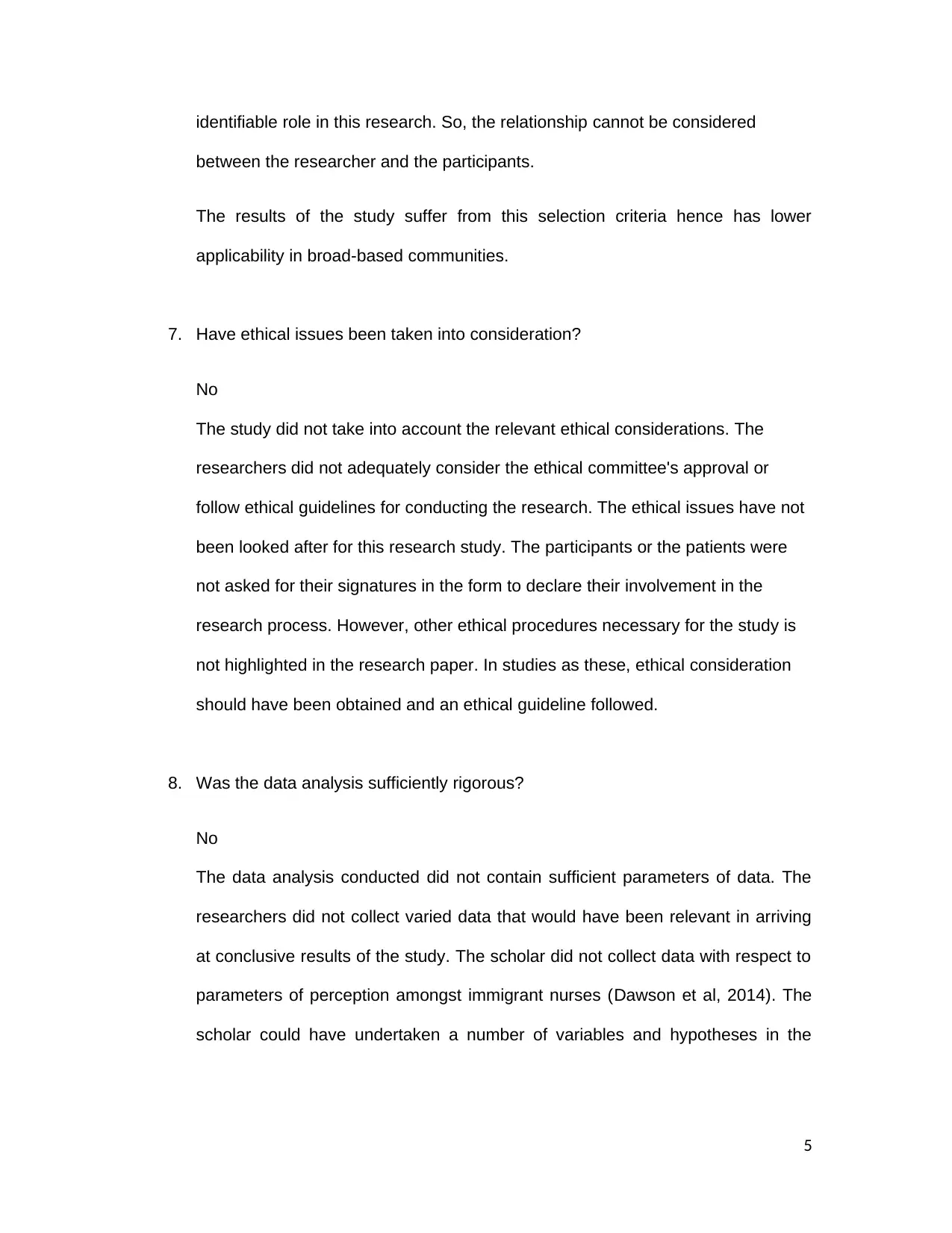
identifiable role in this research. So, the relationship cannot be considered
between the researcher and the participants.
The results of the study suffer from this selection criteria hence has lower
applicability in broad-based communities.
7. Have ethical issues been taken into consideration?
No
The study did not take into account the relevant ethical considerations. The
researchers did not adequately consider the ethical committee's approval or
follow ethical guidelines for conducting the research. The ethical issues have not
been looked after for this research study. The participants or the patients were
not asked for their signatures in the form to declare their involvement in the
research process. However, other ethical procedures necessary for the study is
not highlighted in the research paper. In studies as these, ethical consideration
should have been obtained and an ethical guideline followed.
8. Was the data analysis sufficiently rigorous?
No
The data analysis conducted did not contain sufficient parameters of data. The
researchers did not collect varied data that would have been relevant in arriving
at conclusive results of the study. The scholar did not collect data with respect to
parameters of perception amongst immigrant nurses (Dawson et al, 2014). The
scholar could have undertaken a number of variables and hypotheses in the
5
between the researcher and the participants.
The results of the study suffer from this selection criteria hence has lower
applicability in broad-based communities.
7. Have ethical issues been taken into consideration?
No
The study did not take into account the relevant ethical considerations. The
researchers did not adequately consider the ethical committee's approval or
follow ethical guidelines for conducting the research. The ethical issues have not
been looked after for this research study. The participants or the patients were
not asked for their signatures in the form to declare their involvement in the
research process. However, other ethical procedures necessary for the study is
not highlighted in the research paper. In studies as these, ethical consideration
should have been obtained and an ethical guideline followed.
8. Was the data analysis sufficiently rigorous?
No
The data analysis conducted did not contain sufficient parameters of data. The
researchers did not collect varied data that would have been relevant in arriving
at conclusive results of the study. The scholar did not collect data with respect to
parameters of perception amongst immigrant nurses (Dawson et al, 2014). The
scholar could have undertaken a number of variables and hypotheses in the
5
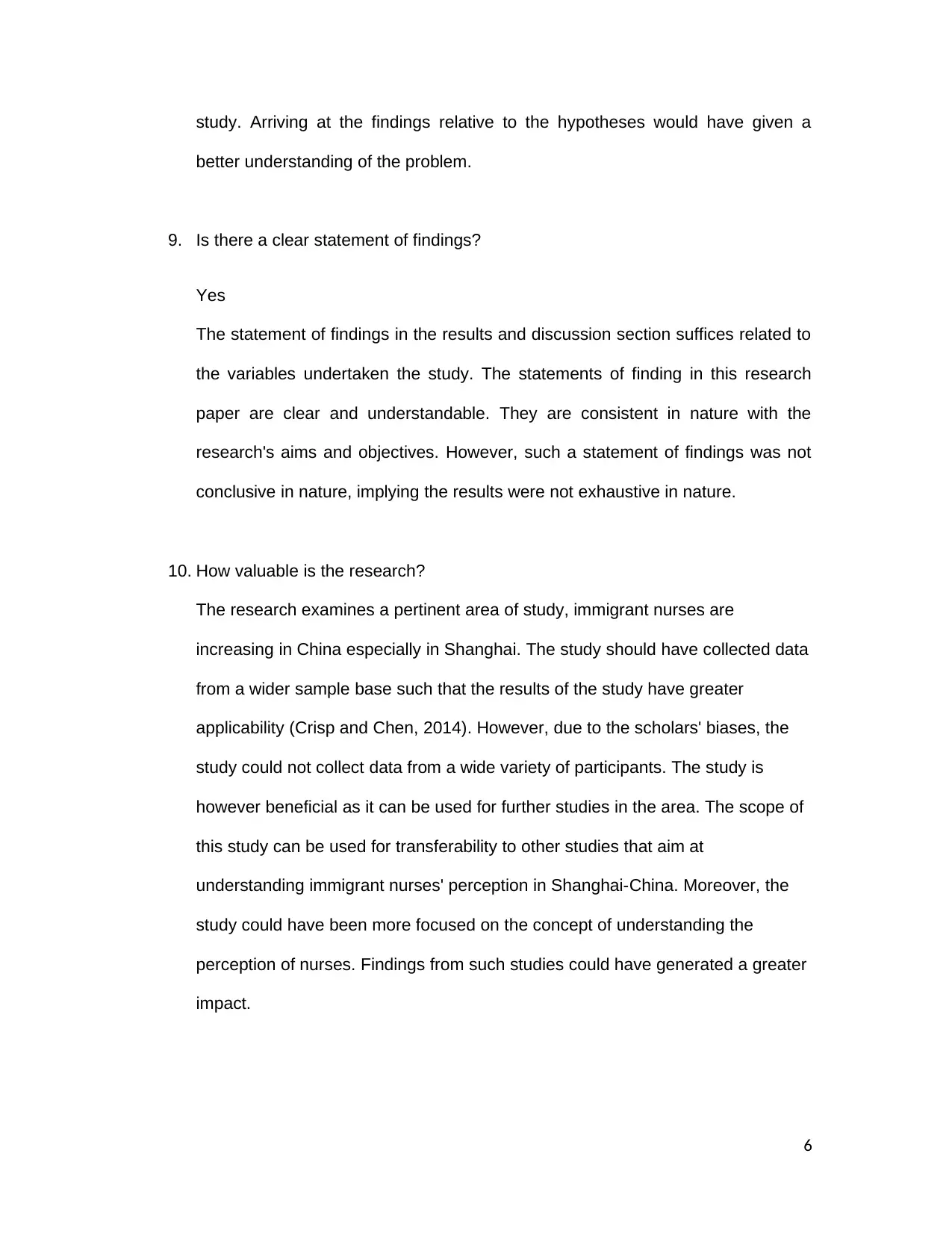
study. Arriving at the findings relative to the hypotheses would have given a
better understanding of the problem.
9. Is there a clear statement of findings?
Yes
The statement of findings in the results and discussion section suffices related to
the variables undertaken the study. The statements of finding in this research
paper are clear and understandable. They are consistent in nature with the
research's aims and objectives. However, such a statement of findings was not
conclusive in nature, implying the results were not exhaustive in nature.
10. How valuable is the research?
The research examines a pertinent area of study, immigrant nurses are
increasing in China especially in Shanghai. The study should have collected data
from a wider sample base such that the results of the study have greater
applicability (Crisp and Chen, 2014). However, due to the scholars' biases, the
study could not collect data from a wide variety of participants. The study is
however beneficial as it can be used for further studies in the area. The scope of
this study can be used for transferability to other studies that aim at
understanding immigrant nurses' perception in Shanghai-China. Moreover, the
study could have been more focused on the concept of understanding the
perception of nurses. Findings from such studies could have generated a greater
impact.
6
better understanding of the problem.
9. Is there a clear statement of findings?
Yes
The statement of findings in the results and discussion section suffices related to
the variables undertaken the study. The statements of finding in this research
paper are clear and understandable. They are consistent in nature with the
research's aims and objectives. However, such a statement of findings was not
conclusive in nature, implying the results were not exhaustive in nature.
10. How valuable is the research?
The research examines a pertinent area of study, immigrant nurses are
increasing in China especially in Shanghai. The study should have collected data
from a wider sample base such that the results of the study have greater
applicability (Crisp and Chen, 2014). However, due to the scholars' biases, the
study could not collect data from a wide variety of participants. The study is
however beneficial as it can be used for further studies in the area. The scope of
this study can be used for transferability to other studies that aim at
understanding immigrant nurses' perception in Shanghai-China. Moreover, the
study could have been more focused on the concept of understanding the
perception of nurses. Findings from such studies could have generated a greater
impact.
6
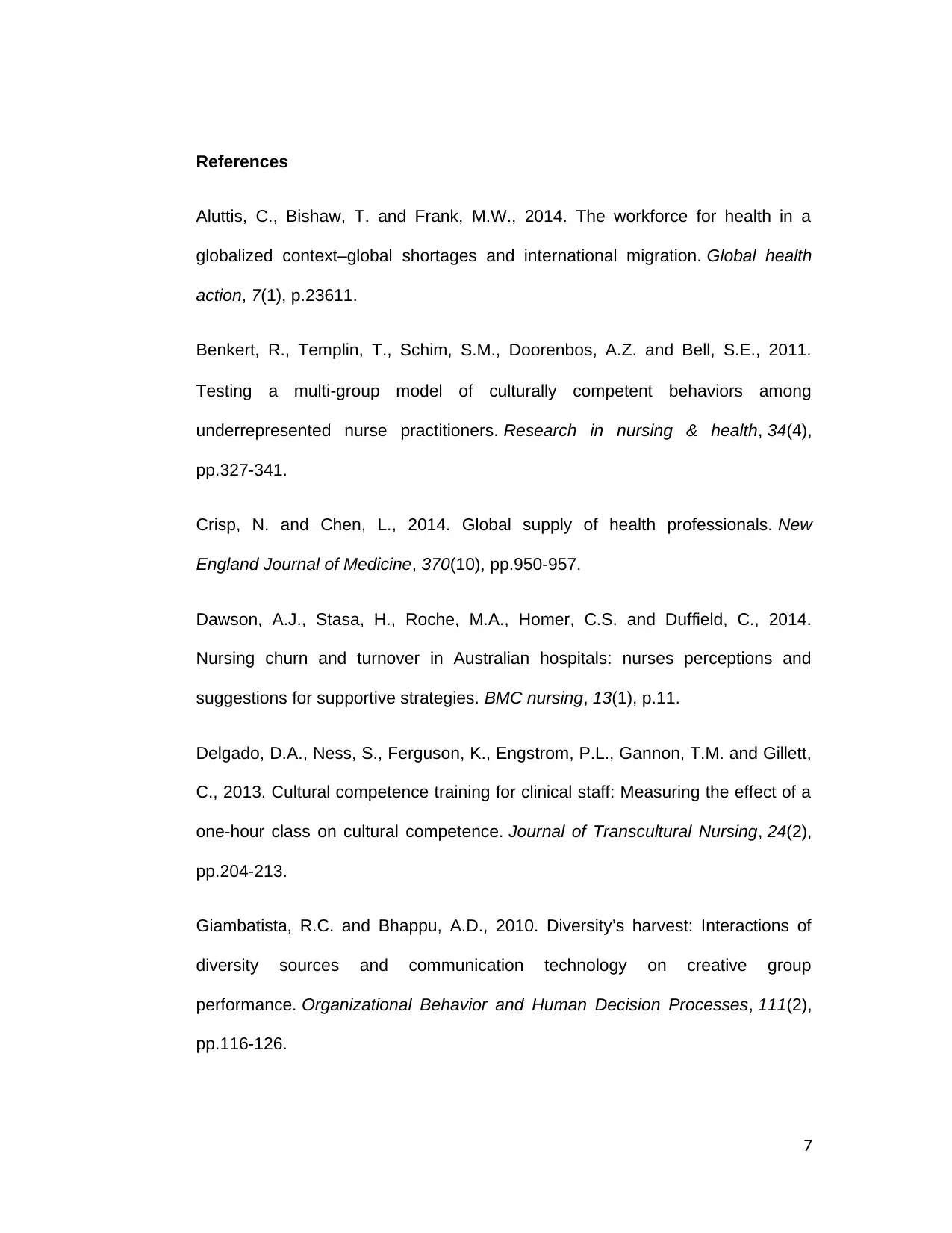
References
Aluttis, C., Bishaw, T. and Frank, M.W., 2014. The workforce for health in a
globalized context–global shortages and international migration. Global health
action, 7(1), p.23611.
Benkert, R., Templin, T., Schim, S.M., Doorenbos, A.Z. and Bell, S.E., 2011.
Testing a multi‐group model of culturally competent behaviors among
underrepresented nurse practitioners. Research in nursing & health, 34(4),
pp.327-341.
Crisp, N. and Chen, L., 2014. Global supply of health professionals. New
England Journal of Medicine, 370(10), pp.950-957.
Dawson, A.J., Stasa, H., Roche, M.A., Homer, C.S. and Duffield, C., 2014.
Nursing churn and turnover in Australian hospitals: nurses perceptions and
suggestions for supportive strategies. BMC nursing, 13(1), p.11.
Delgado, D.A., Ness, S., Ferguson, K., Engstrom, P.L., Gannon, T.M. and Gillett,
C., 2013. Cultural competence training for clinical staff: Measuring the effect of a
one-hour class on cultural competence. Journal of Transcultural Nursing, 24(2),
pp.204-213.
Giambatista, R.C. and Bhappu, A.D., 2010. Diversity’s harvest: Interactions of
diversity sources and communication technology on creative group
performance. Organizational Behavior and Human Decision Processes, 111(2),
pp.116-126.
7
Aluttis, C., Bishaw, T. and Frank, M.W., 2014. The workforce for health in a
globalized context–global shortages and international migration. Global health
action, 7(1), p.23611.
Benkert, R., Templin, T., Schim, S.M., Doorenbos, A.Z. and Bell, S.E., 2011.
Testing a multi‐group model of culturally competent behaviors among
underrepresented nurse practitioners. Research in nursing & health, 34(4),
pp.327-341.
Crisp, N. and Chen, L., 2014. Global supply of health professionals. New
England Journal of Medicine, 370(10), pp.950-957.
Dawson, A.J., Stasa, H., Roche, M.A., Homer, C.S. and Duffield, C., 2014.
Nursing churn and turnover in Australian hospitals: nurses perceptions and
suggestions for supportive strategies. BMC nursing, 13(1), p.11.
Delgado, D.A., Ness, S., Ferguson, K., Engstrom, P.L., Gannon, T.M. and Gillett,
C., 2013. Cultural competence training for clinical staff: Measuring the effect of a
one-hour class on cultural competence. Journal of Transcultural Nursing, 24(2),
pp.204-213.
Giambatista, R.C. and Bhappu, A.D., 2010. Diversity’s harvest: Interactions of
diversity sources and communication technology on creative group
performance. Organizational Behavior and Human Decision Processes, 111(2),
pp.116-126.
7
Paraphrase This Document
Need a fresh take? Get an instant paraphrase of this document with our AI Paraphraser
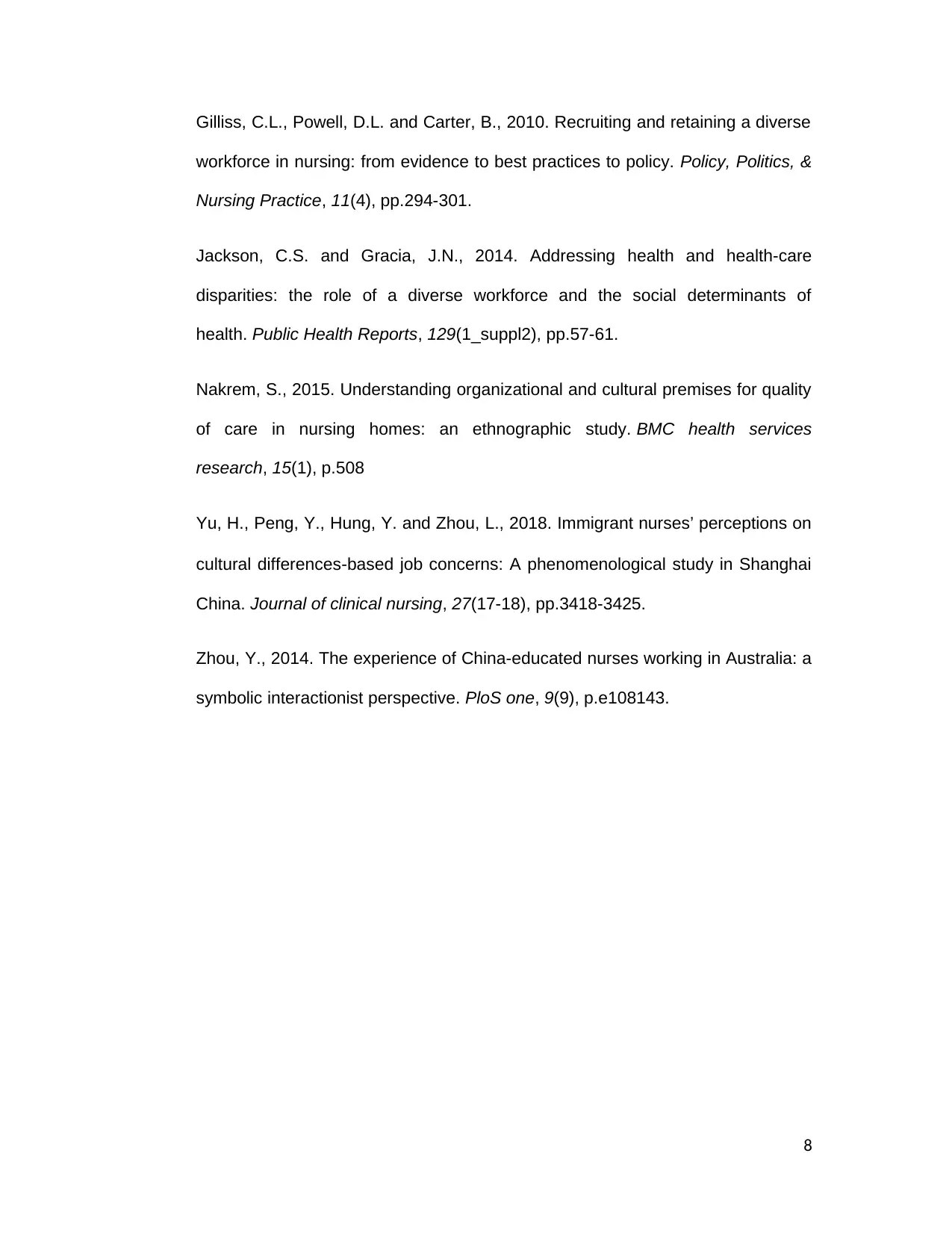
Gilliss, C.L., Powell, D.L. and Carter, B., 2010. Recruiting and retaining a diverse
workforce in nursing: from evidence to best practices to policy. Policy, Politics, &
Nursing Practice, 11(4), pp.294-301.
Jackson, C.S. and Gracia, J.N., 2014. Addressing health and health-care
disparities: the role of a diverse workforce and the social determinants of
health. Public Health Reports, 129(1_suppl2), pp.57-61.
Nakrem, S., 2015. Understanding organizational and cultural premises for quality
of care in nursing homes: an ethnographic study. BMC health services
research, 15(1), p.508
Yu, H., Peng, Y., Hung, Y. and Zhou, L., 2018. Immigrant nurses’ perceptions on
cultural differences‐based job concerns: A phenomenological study in Shanghai
China. Journal of clinical nursing, 27(17-18), pp.3418-3425.
Zhou, Y., 2014. The experience of China-educated nurses working in Australia: a
symbolic interactionist perspective. PloS one, 9(9), p.e108143.
8
workforce in nursing: from evidence to best practices to policy. Policy, Politics, &
Nursing Practice, 11(4), pp.294-301.
Jackson, C.S. and Gracia, J.N., 2014. Addressing health and health-care
disparities: the role of a diverse workforce and the social determinants of
health. Public Health Reports, 129(1_suppl2), pp.57-61.
Nakrem, S., 2015. Understanding organizational and cultural premises for quality
of care in nursing homes: an ethnographic study. BMC health services
research, 15(1), p.508
Yu, H., Peng, Y., Hung, Y. and Zhou, L., 2018. Immigrant nurses’ perceptions on
cultural differences‐based job concerns: A phenomenological study in Shanghai
China. Journal of clinical nursing, 27(17-18), pp.3418-3425.
Zhou, Y., 2014. The experience of China-educated nurses working in Australia: a
symbolic interactionist perspective. PloS one, 9(9), p.e108143.
8
1 out of 8
Your All-in-One AI-Powered Toolkit for Academic Success.
+13062052269
info@desklib.com
Available 24*7 on WhatsApp / Email
![[object Object]](/_next/static/media/star-bottom.7253800d.svg)
Unlock your academic potential
© 2024 | Zucol Services PVT LTD | All rights reserved.


